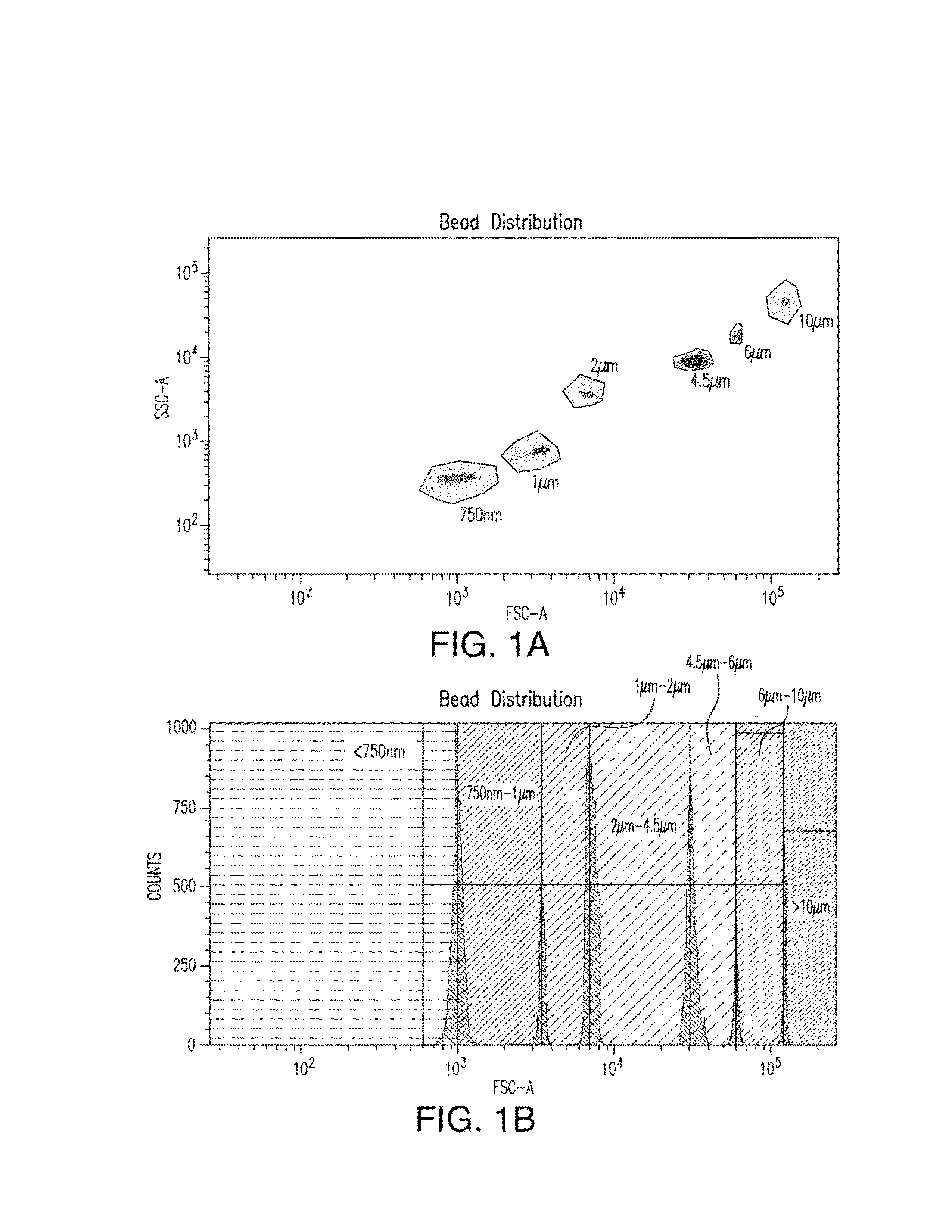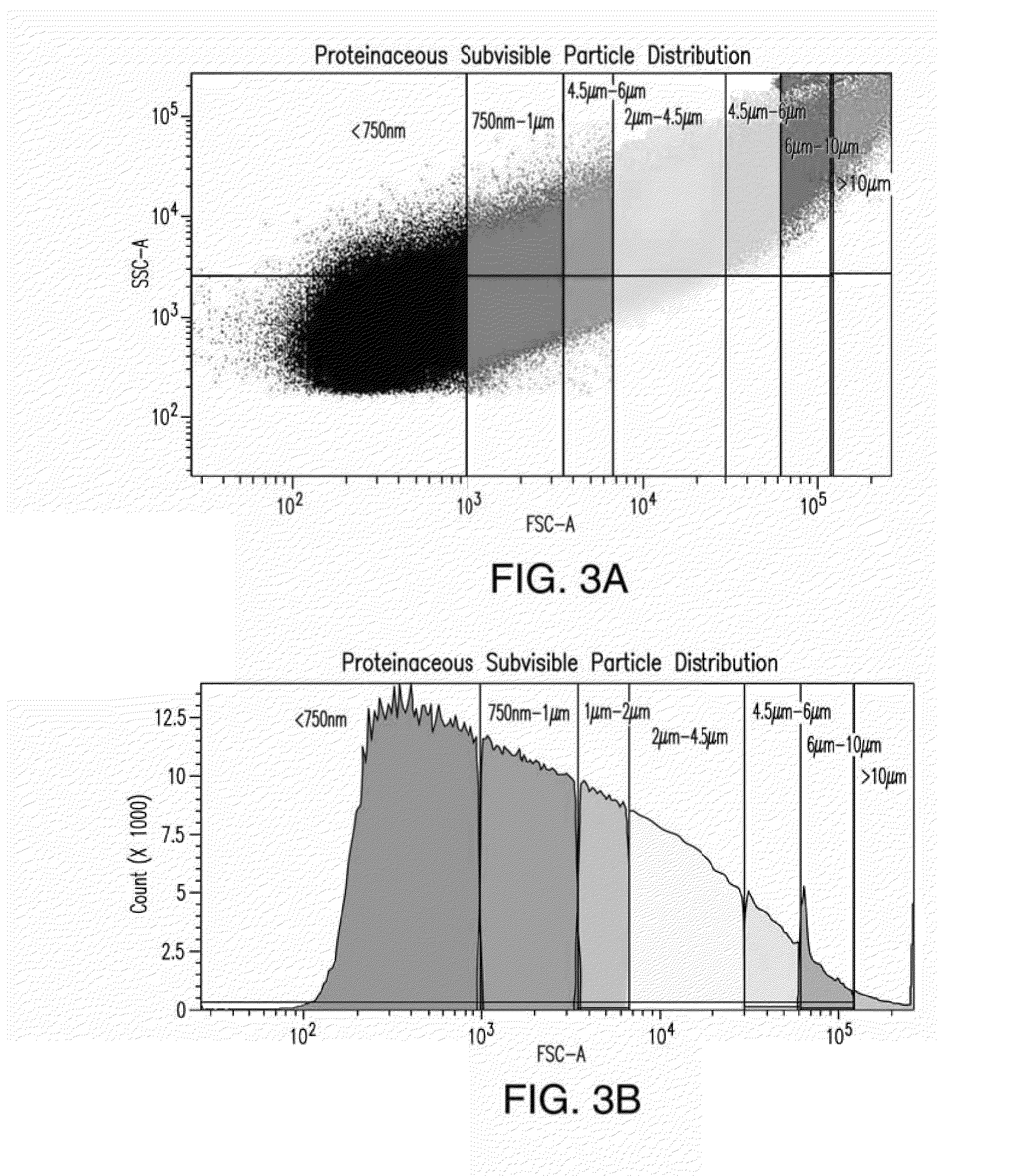Characterization of Subvisible Particles Using a Particle Analyzer
a particle analyzer and sub-visible technology, applied in the field of characterization of sub-visible particles using a particle analyzer, can solve the problems of significant morbidity, patient suffering and even death, and the immune response can have devastating effects
- Summary
- Abstract
- Description
- Claims
- Application Information
AI Technical Summary
Benefits of technology
Problems solved by technology
Method used
Image
Examples
example 1
Establishing Limits of Size Detection and Size Distribution Ranges
[0163]To be able to establish size distribution ranges a size standard stock solution was prepared from Fluoresbright Size Calibration Kit I and II (Polysciences, Inc., Warrington, Pa.). This stock solution included microspheres having mean diameters of 0.75 μm, 1.0 μm, 2.0 μm, 4.5 μm, 6.0 μm and 10 μm and was prepared according to the manufacturer's instructions.
[0164]The prepared test sample was analyzed using a BD LSRFORTESSA™ particle analyzer (Becton Dickinson, San Jose, Calif.) equipped with a 405-nm violet laser, a 488-nm blue laser, a 561-nm yellow / green laser and a 635-nm red laser; and having two 488-nm light scattering detectors (low-angle forward scattering [FSC] and 90° side scattering [SSC]) and 16 fluorescence detectors. The forward and the side scatter were illustrated logarithmically. A threshold was set on the forward and side scatter in a manner that would include particles on the forward scatter vs...
example 2
Establishing Limits of Size Detection and Size Distribution Ranges
[0166]To be able to establish size distribution ranges a size standard stock solution was prepared from Fluoresbright Size Calibration Kit I and II (Polysciences, Inc., Warrington, Pa.). This stock solution included microspheres having mean diameters of 0.75 μm, 1.0 μm, 2.0 μm, 4.5 μm, 6.0 μm and 10 μm and was prepared according to the manufacturer's instructions.
[0167]The prepared test sample was analyzed using a BD FACSARIAIII™ particle analyzer (Becton Dickinson, San Jose, Calif.) equipped with a 405-nm violet laser, a 488-nm blue laser and a 633-nm red laser; and having two 488-nm light scattering detectors (low-angle forward scattering [FSC] and 90° side scattering [SSC]) and 11 fluorescence detectors. The forward and the side scatter were illustrated logarithmically. A threshold was set on the forward and side scatter in a manner that would include particles on the forward scatter vs. side scatter plot but still...
example 3
Detecting, Counting and Determination of Size Distribution of Particles
[0169]To prepare a test sample, 50 μL (about 49,500 microspheres) of COUNTBRIGHT™ Absolute Counting Beads (Invitrogen, Life Technologies Ltd., Paisley, Great Britain) were added to 450 μL of a particle sample including 50 μg / mL amyloid β peptide 1-42 aggregates.
[0170]The prepared test sample was analyzed using a BD LSRFORTESSA™ particle analyzer (Becton Dickinson, San Jose, Calif.) as described in Example 1. The stored settings, thresholds, and gates determined by the size standard in Example 1 were used as a template for size distribution ranges. All events were analyzed, recorded, and evaluated as described in Example 1. Each sample was evaluated three times and a mean value and standard deviations of the three results were calculated. A control sample comprising formulation buffers was analyzed in parallel to record the background signal for the corresponding test sample. Background signals were subtracted fro...
PUM
| Property | Measurement | Unit |
|---|---|---|
| fluorescence excitation wavelength | aaaaa | aaaaa |
| fluorescence emission wavelength | aaaaa | aaaaa |
| fluorescence emission wavelength | aaaaa | aaaaa |
Abstract
Description
Claims
Application Information
 Login to View More
Login to View More - R&D
- Intellectual Property
- Life Sciences
- Materials
- Tech Scout
- Unparalleled Data Quality
- Higher Quality Content
- 60% Fewer Hallucinations
Browse by: Latest US Patents, China's latest patents, Technical Efficacy Thesaurus, Application Domain, Technology Topic, Popular Technical Reports.
© 2025 PatSnap. All rights reserved.Legal|Privacy policy|Modern Slavery Act Transparency Statement|Sitemap|About US| Contact US: help@patsnap.com



